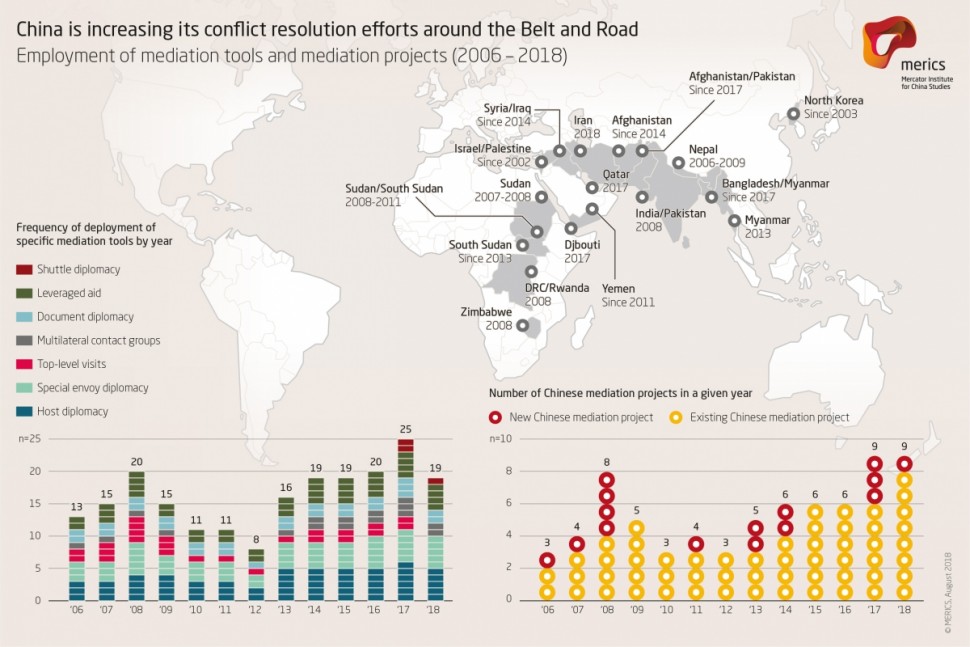
China as a conflict mediator
Maintaining stability along the Belt and Road
Recent years have seen significant changes in China’s international mediation activities. In countries like Afghanistan, Bangladesh, Syria and Israel, among others, diplomats from China increasingly engage in preventing, managing or resolving conflict. In 2017 Beijing was mediating in nine conflicts, a visible increase compared to only three in 2012, the year when Xi Jinping took power as General Secretary of the Chinese Communist Party (CCP).
The increase in Chinese mediation activities began in 2013, the year that the Belt and Road Initiative (BRI) was launched. Before that, Beijing was relatively reluctant to engage in conflict resolution abroad. As the MERICS mapping shows, the year 2008 is an outlier in that regard. China’s activities at the time – such as its efforts to mediate between the Democratic Republic of Congo and Rwanda, or between Sudan and South Sudan – were probably part of Beijing’s charm offensive and its drive to gain more international visibility in the run-up to the 2008 Beijing Olympic Games.
But things changed with the kick-off of BRI: Beijing now pays more attention to its international mediation efforts and publicizes its activities more actively, both through top leadership statements and greater media coverage. Driven by the BRI, Beijing has also shifted the focus of its mediation efforts to South Asia, the Middle East and East Africa – regions that are strategically important for the initiative.
These changes are mostly motivated by domestic interests. The Chinese government is, first and foremost, interested in preserving stability along the Belt and Road to allow for the smooth flow of trade and investment through unstable regions and to improve the security conditions for Chinese citizens and companies living and operating there. Beijing is aware that, without some measure of stability in key countries along the BRI, the initiative is likely to fail.
Furthermore, China’s growing involvement in conflict mediation, along with the increased attention these activities are receiving, helps play up the country’s self-crafted image as a responsible global power. Xi, who has outlined his goal to turn China into a global power by 2049, wants his country to stand out as a constructive player on the international stage, in contrast to the United States under President Donald Trump’s America First policies. Additionally, mediating in longstanding conflicts may give China an opportunity to influence, to some extent, the fate of governments in key countries, potentially allowing Beijing to protect and, therefore, help keep in power, regimes that are close to the CCP, such as Bashar al-Assad’s government in Syria or the military-backed government in Myanmar.
China favors high-profile, multinational mediation efforts in BRI countries
China’s ambition in conflict mediation becomes apparent when looking at the nine conflicts or crises it mediated (or attempted to mediate) in 2017. All of them have high international visibility, such as the civil war in Syria, the Israel-Palestine conflict or the Bangladesh-Myanmar dispute over the Rohingya people. Besides, as shown in the map, with the exception of China’s mediation in the conflicts in North Korea and South Sudan, all its activities are located along the Belt and Road. The high international visibility of these conflicts is a clear departure from the lower-profile approach China took in the late 2000s, when it attempted to mediate in mostly domestic political conflicts in Nepal or Zimbabwe.
In most of these nine cases, Beijing is not the only party involved in the mediation process. Often there is either a multinational effort to resolve the conflict, like in Afghanistan, or China is just one of several actors trying to mediate between warring factions, such as in the case of the Israel-Palestine conflict. This approach lets China present itself as a responsible global actor to a wider global public, allowing Beijing to take credit for trying to solve these conflicts, domestically and internationally. Besides, getting involved in multinational initiatives, even in a passive manner, lets Beijing take credit for any potential successes of these processes, while evading full responsibility if efforts are unsuccessful. This has long been China’s approach to international mediation, but it is becoming more obvious now that Beijing is diving into conflicts that have higher international visibility and could thus cause stronger international backlash if China’s efforts worsened the situation.
China also continues to rely on its traditional approach to mediation, which revolves around high-profile mediation tools that target the top levels of governments, including host diplomacy activities, top-level visits and special envoys. This approach has the benefit of providing Beijing with media attention and direct access to local governments, but it has so far proved ineffective. Beijing has failed to produce a long-term sustainable peace process in any of the conflicts it is involved in.
The reasons for this lack of success are varied, and some of them are beyond China’s control. However, when it comes to mediation, Beijing’s approach does not follow international good practice. According to standards such as the UN Guidance on Effective Mediation, a good mediation process should respond to the specificity of each conflict and consider a number of fundamentals, including consent, impartiality, inclusivity and national ownership. China’s approach, however, is largely similar across all conflicts it is involved in. And by focusing only on high-visibility, top-level tools and engagement, China fails to broaden the process and include the perspectives of other stakeholders beyond governments and other conflict parties.
Opportunities for Europe-China cooperation in mediation exist, but caution is key
For now, China’s international mediation efforts tend to focus on conflict management and stability preservation rather than on long-term conflict resolution. But despite this narrower focus, Europe and China have a common interest in maintaining stability and managing conflicts while working on lasting peace agreements, especially in countries and regions that are close to Europe’s borders. European countries have a strong interest in security and stability in their neighborhood, as well as in other strategically and economically important regions, in order to protect their own strategic interests and prevent an increase of migration from conflict zones into Europe. There could therefore be opportunities for cooperation and coordination between Beijing and the EU member states in certain cases where the interests of both parties overlap, such as the Iran nuclear deal crisis or the conflict between Israel and Palestine. However, Europe has to be aware of the domestic interests driving Chinese mediation activities, as well as their shortcomings. There is a chance that Europe, as a major player in international mediation, may have to pick up the pieces if China’s efforts go wrong.
A potential friction area in the future is the conflict in Syria, where China’s mediation activities have focused on maintaining Bashar al-Assad’s government in power, along with Russia, and insisting on a political solution to the civil war while blocking UN resolutions that condemned the actions of the Syrian government and launched investigations into the regime’s actions. This contradicts the interests of the EU, whose mediation efforts are focused on bringing an end to the war through a genuine political transition while promoting democracy and accountability for war crimes.
Despite this, China’s potential in the field of mediation cannot be denied: in many countries along the BRI, especially in the Middle East, China is seen as a relatively honest broker since it does not carry the same historical baggage as the United States or European countries, due to its very limited presence in the region in the past. This has allowed Beijing to engage all conflict parties in various countries, such as in the peace process in Afghanistan, where China has been willing and able to engage both the government in Kabul and the Taliban. The international community would certainly welcome a China-brokered peace agreement in any of the conflicts Beijing is currently involved in. However, given China’s current approach to mediation, such a positive outcome seems unlikely for now.

